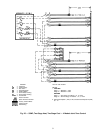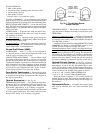
HEATING (48MA) — On call for heating from a zone, the
forced draft blower will start and the pilot will light. The
zone burner will ignite after the pilot has been proven. (Ap-
proximately 60 seconds.)
NOTE: A time-delay relay will shut unit down in 180 sec-
onds if the unit main gas valve is not open.
HEATING (50ME WITH ELECTRIC HEAT) — On a call
for heating from a zone, the first-stage heating relay, con-
tactor, and heating element are energized. Upon additional
calls for heating from that zone, stage 2 is energized in a
similar manner. However, second element on 2-element heater
assemblies and second and third heating elements on 3-element
heater assemblies are energized as described in Outdoor Air
Thermostat Adjustment section on page 36.
Heating Lockout (50ME with Electric Heat) — If any zone
module is operating on mechanical cooling (Compressor[s]
is operating), one heating element in each zone module is
locked out and zone module cannot be energized. Operation
of lockout circuit is independent of outdoor-air thermostat
operation.
HEATING (50ME WITH GLYCOL HEATING COILS) —
On a call for heating from a zone, the heating relay and heat-
ing coil solenoid valve for that zone are energized. If 2 or
more unit zone modules are joined to serve a common zone,
stage 2 of heating thermostat operates remaining heating
relays and solenoid valves depending on connection
arrangement.
OUTDOOR-AIR DAMPER — This control regulates the
amount of outdoor air that passes through the outdoor air
evaporator coil and enters the return air-stream (Fig. 34 and
35). A knob in the zone control and thermostat panel acti-
vates the damper control motor (damper operator). Damper
may be fully closed, fully open, or set at any intermediate
position by setting the knob as desired. In the fully open po-
sition, the damper will permit 25% outdoor air and 75% re-
turn air into the unit.
SERVICE
Cabinet Panels and Grilles
SIDE PANELS — To remove a panel, remove lower screw
on T-fastener. Loosen T-fastener pivot screw. Swing aside
T-fastener. Pull bottom of panel out and down.
TOP PANELS — Remove end caps from each end of rain
covers. Remove panel screws and lift off panels as required.
Save end caps and screws for reinstallation.
HEATERACCESS PANELS — See Side Panels section above.
Cleaning — Inspect unit interior at the beginning of each
heating and cooling season and during each season as op-
erating conditions require. Remove unit side panels and top
panels to expose unit interior as required.
EVAPORATOR COILS (ZONE COOLING COILS) AND
GLYCOL HEATING COILS — Clean with a stiff brush,
vacuum cleaner, or compressed air.
CONDENSER AND OUTDOOR-AIR COOLING COILS
— Clean with a stiff brush or vacuum cleaner. If cleaning
with compressed air or low-pressure water or steam, guard
against damaging compressor, wiring, and nearby controls.
CONDENSATE DRAINS — Check and clean annually at
start of cooling season.
INDOOR-AIR FILTERS — Clean or replace filters at start
of each heating and cooling season and as often as necessary
during each season, depending on operating conditions. Re-
fer to Table 1 for type and size of filters used. Filter section
is shown in Fig. 34 and 35. Indoor-air filter tracks will ac-
cept 2 layers of one-in. thick filters.
OUTDOOR-AIR INLET SCREENS — Clean with steam or
hot water and mild detergent.
GAS HEATING SECTION — Inspect burners and heat ex-
changers before each heating season. Remove exhaust grilles
to inspect heat exchangers. Clean with wire brush if there is
any accumulation of debris. The main burners should also
be cleaned if there is any accumulation of debris. Fire each
zone to be assured of proper operation. Correct pilot height
is1to1
1
⁄
2
inches.
COMBUSTION AIR FAN — Inspect blower wheel for dirt,
and remove and clean if necessary.
Airflow Switches
INDOOR AIRFLOW SWITCH (AFS1) — This switch is
located in evaporator fan inlet venturi. This switch will shut
down unit if airflow through zone modules is insufficient.
COMBUSTIONAIRFLOW SWITCH (AFS2) — This switch
(48MAonly) is located in combustion air plenum. This switch
will shut down unit heating mode if combustion air is in-
sufficient. See Forced-Draft Blower (48MA) section on
page 42 for details on combustion air shutter adjustment.
Service Switch — A control circuit service switch is
located in the power and condensing control box (Fig. 34
and 35). Shut down unit (compressors, fans, and control cir-
cuits) at this switch.
Do not use compressor circuit breakers to start and stop
compressors except in emergency.
Time Guardா Control Circuit — Each compressor
circuit has a 5-minute delay before restarting compressor af-
ter shutdown for any reason. On starting, Time Guard device
timer causes a delay of 15 seconds after thermostat closes
before compressor starts. On compressor shutdown, timer re-
cycles for 4 minutes, 45 seconds. During this time, compres-
sor cannot restart.
On 2-compressor units, no. 2 compressor will not start for
at least 2
1
⁄
2
minutes after no. 1 compressor starts. See
Capacity Control Pressure Switches section below.
Capacity Control Pressure Switches (CCP)
(2-Compressor Units Only) —
These switches are
connected to the suction side of the system on compressor
no. 2.Approximately 2
1
⁄
2
minutes after compressor no. 2 starts,
the timer makes the circuit to CCP1 and CCP2 to operate
compressor no. 2 as follows:
1. CCP1 is open (opens at 63 psig; closes at 83 psig). This
prevents cycling of compressor no. 2 at start-up.
2. CCP2 is closed (opens at 54 psig; closes at 78 psig).
3. Holding relay no. 2 (HR2) is deenergized.
When the suction pressure reaches 83 psig, CCP1 closes
to energize HR2 and compressor no. 2. Compressor no. 2
will then be operated by CCP2.
Compressor Oil — Compressors have their own oil sup-
ply. Compressor crankcases on 2-compressor units are in-
terconnected. Loss of oil due to a leak in the system should
be the only reason for adding oil after unit has been in op-
eration. A sight glass is provided in the crankcase intercon-
nection line or on the compressor crankcase. Remove end
panels to gain access to compressors. Sight glass on 06D
compressor should be about
1
⁄
3
to
2
⁄
3
full of oil. Sight glass
on 06E compressor should be about
1
⁄
8
to
1
⁄
2
full of oil.
Compressor data is shown in Table 1 and on dataplate at-
tached to compressor body. Refer to 06D or 06E Compres-
sor Service Manual for additional compressor service
information.
39


















